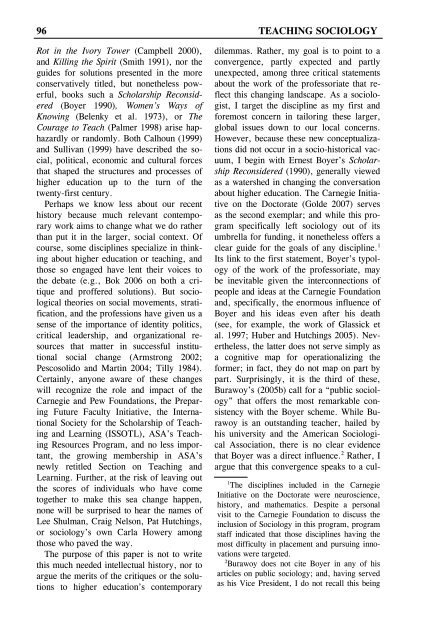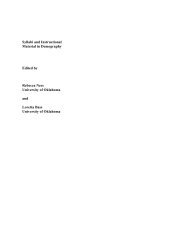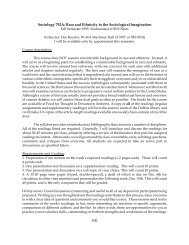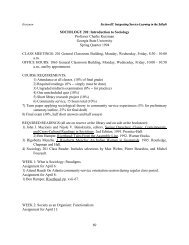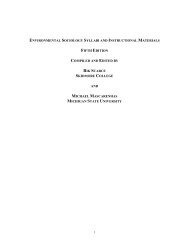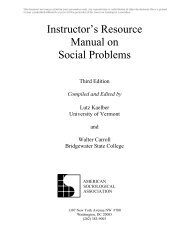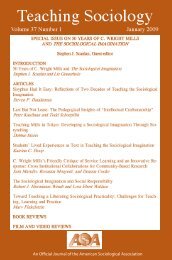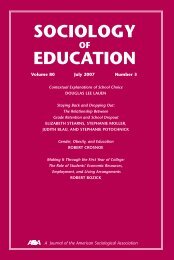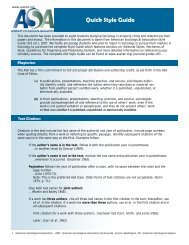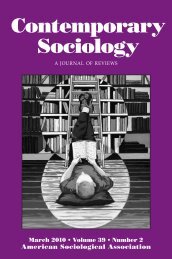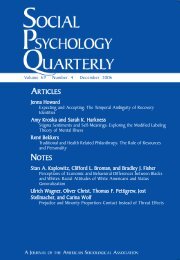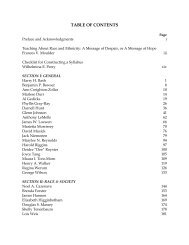3337 TS Vol36_2_APRIL 08 - American Sociological Association
3337 TS Vol36_2_APRIL 08 - American Sociological Association
3337 TS Vol36_2_APRIL 08 - American Sociological Association
You also want an ePaper? Increase the reach of your titles
YUMPU automatically turns print PDFs into web optimized ePapers that Google loves.
96 TEACHING SOCIOLOGY<br />
Rot in the Ivory Tower (Campbell 2000),<br />
and Killing the Spirit (Smith 1991), nor the<br />
guides for solutions presented in the more<br />
conservatively titled, but nonetheless powerful,<br />
books such a Scholarship Reconsidered<br />
(Boyer 1990), Women’s Ways of<br />
Knowing (Belenky et al. 1973), or The<br />
Courage to Teach (Palmer 1998) arise haphazardly<br />
or randomly. Both Calhoun (1999)<br />
and Sullivan (1999) have described the social,<br />
political, economic and cultural forces<br />
that shaped the structures and processes of<br />
higher education up to the turn of the<br />
twenty-first century.<br />
Perhaps we know less about our recent<br />
history because much relevant contemporary<br />
work aims to change what we do rather<br />
than put it in the larger, social context. Of<br />
course, some disciplines specialize in thinking<br />
about higher education or teaching, and<br />
those so engaged have lent their voices to<br />
the debate (e.g., Bok 2006 on both a critique<br />
and proffered solutions). But sociological<br />
theories on social movements, stratification,<br />
and the professions have given us a<br />
sense of the importance of identity politics,<br />
critical leadership, and organizational resources<br />
that matter in successful institutional<br />
social change (Armstrong 2002;<br />
Pescosolido and Martin 2004; Tilly 1984).<br />
Certainly, anyone aware of these changes<br />
will recognize the role and impact of the<br />
Carnegie and Pew Foundations, the Preparing<br />
Future Faculty Initiative, the International<br />
Society for the Scholarship of Teaching<br />
and Learning (ISSOTL), ASA’s Teaching<br />
Resources Program, and no less important,<br />
the growing membership in ASA’s<br />
newly retitled Section on Teaching and<br />
Learning. Further, at the risk of leaving out<br />
the scores of individuals who have come<br />
together to make this sea change happen,<br />
none will be surprised to hear the names of<br />
Lee Shulman, Craig Nelson, Pat Hutchings,<br />
or sociology’s own Carla Howery among<br />
those who paved the way.<br />
The purpose of this paper is not to write<br />
this much needed intellectual history, nor to<br />
argue the merits of the critiques or the solutions<br />
to higher education’s contemporary<br />
dilemmas. Rather, my goal is to point to a<br />
convergence, partly expected and partly<br />
unexpected, among three critical statements<br />
about the work of the professoriate that reflect<br />
this changing landscape. As a sociologist,<br />
I target the discipline as my first and<br />
foremost concern in tailoring these larger,<br />
global issues down to our local concerns.<br />
However, because these new conceptualizations<br />
did not occur in a socio-historical vacuum,<br />
I begin with Ernest Boyer’s Scholarship<br />
Reconsidered (1990), generally viewed<br />
as a watershed in changing the conversation<br />
about higher education. The Carnegie Initiative<br />
on the Doctorate (Golde 2007) serves<br />
as the second exemplar; and while this program<br />
specifically left sociology out of its<br />
umbrella for funding, it nonetheless offers a<br />
clear guide for the goals of any discipline. 1<br />
Its link to the first statement, Boyer’s typology<br />
of the work of the professoriate, may<br />
be inevitable given the interconnections of<br />
people and ideas at the Carnegie Foundation<br />
and, specifically, the enormous influence of<br />
Boyer and his ideas even after his death<br />
(see, for example, the work of Glassick et<br />
al. 1997; Huber and Hutchings 2005). Nevertheless,<br />
the latter does not serve simply as<br />
a cognitive map for operationalizing the<br />
former; in fact, they do not map on part by<br />
part. Surprisingly, it is the third of these,<br />
Burawoy’s (2005b) call for a “public sociology”<br />
that offers the most remarkable consistency<br />
with the Boyer scheme. While Burawoy<br />
is an outstanding teacher, hailed by<br />
his university and the <strong>American</strong> <strong>Sociological</strong><br />
<strong>Association</strong>, there is no clear evidence<br />
that Boyer was a direct influence. 2 Rather, I<br />
argue that this convergence speaks to a cul-<br />
1 The disciplines included in the Carnegie<br />
Initiative on the Doctorate were neuroscience,<br />
history, and mathematics. Despite a personal<br />
visit to the Carnegie Foundation to discuss the<br />
inclusion of Sociology in this program, program<br />
staff indicated that those disciplines having the<br />
most difficulty in placement and pursuing innovations<br />
were targeted.<br />
2 Burawoy does not cite Boyer in any of his<br />
articles on public sociology; and, having served<br />
as his Vice President, I do not recall this being


